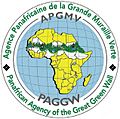Great Green Wall facts for kids
The Great Green Wall of Africa is an amazing project to grow a huge strip of trees and plants across Africa. It's like building a living wall to help stop the Sahara Desert from spreading further south. This desert expansion affects the lives of millions of people, including many children, by making land dry and hard to live on. The plan is for this green strip to be about 15 kilometers (about 9 miles) wide. It aims to bring life back to dry lands and help communities thrive.
Contents
What is the Great Green Wall?
The Great Green Wall is a very ambitious plan led by the African Union. It started in 2007 with the goal of growing an 8,000-kilometer (about 5,000-mile) long and 15-kilometer (9-mile) wide natural barrier. This barrier stretches across the entire width of Africa, from Senegal in the west to Djibouti in the east. It's not just about planting trees in a straight line. It's also about restoring land, improving farming methods, and helping local communities.
Why is it Needed?
The main reason for the Great Green Wall is to fight against desertification. This is when fertile land turns into desert, often because of climate change and human activities like cutting down too many trees or overgrazing animals. When land becomes desert, it's very hard to grow food or find water. This can force people to leave their homes and look for new places to live. Countries like Niger, Chad, Sudan, and Mali are especially affected by the Sahara Desert moving south. The Great Green Wall aims to protect these areas and help them become green again.
How Does it Work?
The project involves planting many different types of trees and plants that can survive in dry conditions. But it's more than just planting. It also includes:
- Restoring land: This means helping damaged soil become healthy again so plants can grow.
- Water management: Finding ways to collect and save water, like building small dams or digging wells.
- Sustainable farming: Teaching farmers how to grow food in ways that don't harm the land, like using less water or rotating crops.
- Community involvement: Working with local people to make sure the project helps them directly, for example, by providing jobs or new ways to earn money.
Benefits of the Great Green Wall
The Great Green Wall offers many benefits, not just for the environment but also for the people living in the region.
Helping People and Communities
- Food Security: By making land fertile again, people can grow more food. This means families have enough to eat and don't have to worry about hunger.
- New Jobs: The project creates many jobs, from planting trees to managing nurseries and teaching sustainable farming. This helps people earn money and improve their lives.
- Better Health: A healthier environment can lead to better health for people. More plants mean cleaner air and often more access to nutritious food.
- Stopping Migration: When people can live and thrive in their home areas, they are less likely to have to move away because of lack of resources.
Environmental Impact
- Fighting Climate Change: Trees absorb carbon dioxide, a gas that contributes to climate change. Planting millions of trees helps clean the air and slow down global warming.
- Protecting Biodiversity: As the land becomes greener, more animals and insects can return to the area, creating a richer and more balanced ecosystem.
- Stopping Desertification: The main goal is to create a barrier that slows down the spread of the desert, protecting valuable farmland and water sources.
Challenges and Progress
Building something as massive as the Great Green Wall comes with many challenges.
What Makes it Hard?
- Climate: The areas where trees are planted are very hot and dry, making it difficult for young plants to survive.
- Funding: It costs a lot of money to plant trees, restore land, and support communities over such a huge area.
- Local Support: Sometimes, people living near the project might not understand its long-term benefits. For example, some might cut down young trees for firewood or building materials if they don't have other options. Educating communities and providing alternative resources is very important.
- Politics: The project involves many different countries, and getting everyone to work together smoothly can be tricky.
How Far Along is it?
Even with these challenges, the Great Green Wall project has made good progress. As of 2020, about 15% of the wall was completed. Millions of hectares (a hectare is about 2.5 acres) of land have been restored, and many trees have been planted. Countries like Ethiopia, Senegal, and Niger have shown great success in their parts of the project. The project is expected to be completed by 2030. It's a long-term effort, but it shows how much can be achieved when people work together for a common goal.
Images for kids


